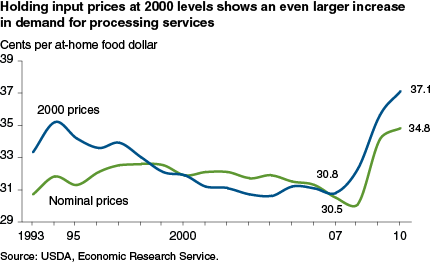Food Processing Costs Per Food-at-Home Dollar Rose Sharply in 2009 and 2010
- by Patrick Canning
- 9/20/2012
In 2010, about 35 cents from each dollar that U.S. consumers spent on U.S.-produced food sold in grocery and other retail foodstores went to food processing establishments like flour mills, meatpacking plants, and dairy processors. This equates to an increase of around 14 percent since 2007, when the share was about 31 cents per dollar spent. Over time, consumers are replacing their purchases of less processed foods with new products, such as bagged salad mixes and ready-to-grill marinated meats, that eliminate most of the post-purchase food preparation work. ERS's Food Dollar Series suggests that this trend has accelerated since 2007.
Food processors transform raw food commodities, such as bushels of wheat or live chickens, into ready-to-eat products like sliced whole wheat bread and canned chicken soup or into 'almost-ready' forms, such as flour and uncooked boneless chicken breasts. The processing share of the food-at-home dollar reflects the salaries and benefits of workers and managers in the processing plants and the capital costs incurred by plant owners and investors. It does not reflect costs incurred by food processors that are paid to other industries, such as energy, packaging, and advertising, which are reported separately.
When prices for all food production inputs (farm commodities, processing, energy, packaging, and others) are held constant at their 2000 levels, processing's share of the at-home food dollar rises even more sharply to 37 cents. This indicates that processing's share has grown not because food companies are charging more for their processing services but because consumers are buying greater quantities of highly processed food products.
This article is drawn from:
- Food Dollar Series. (n.d.). U.S. Department of Agriculture, Economic Research Service.



